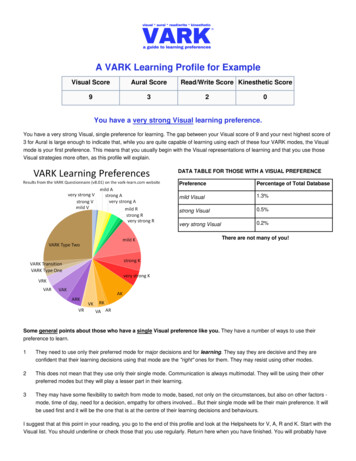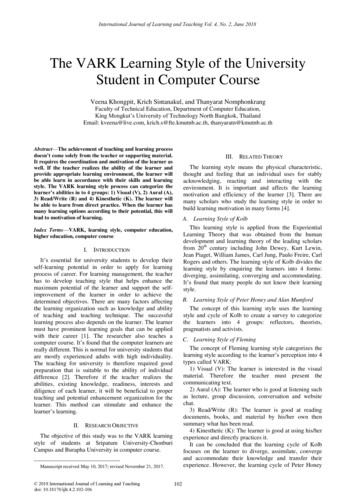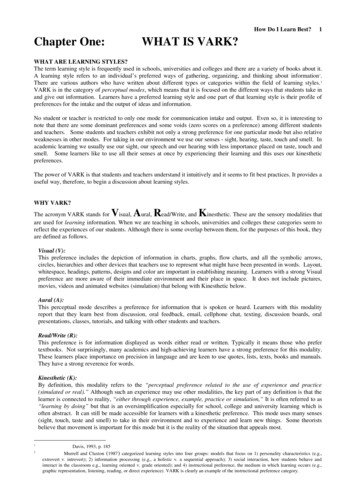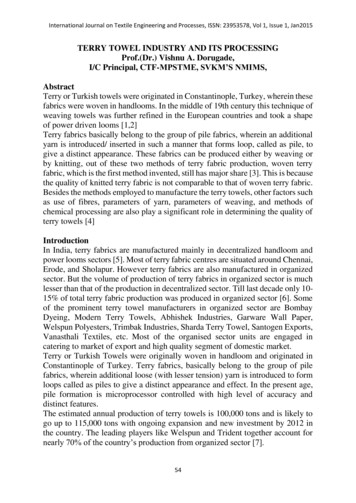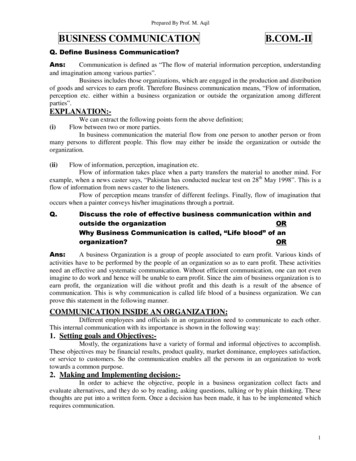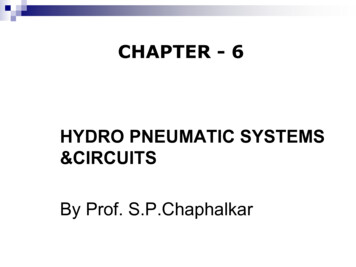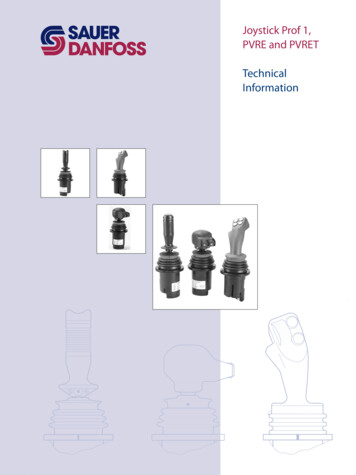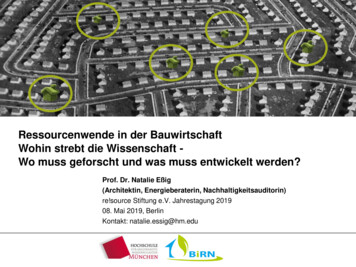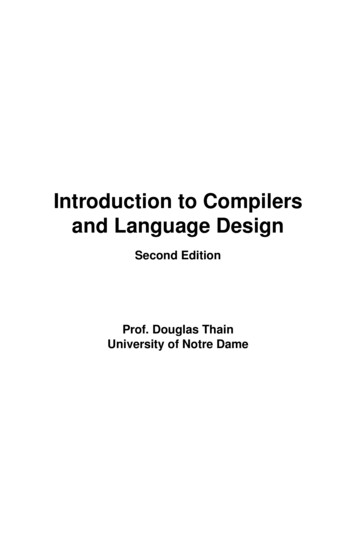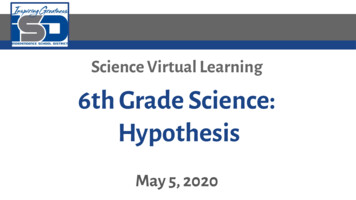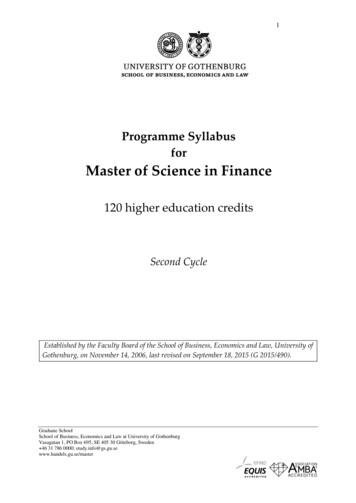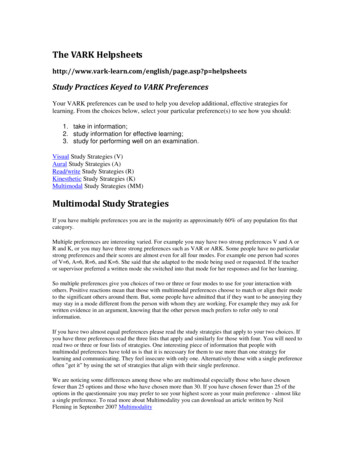
Transcription
The VARK sp?p helpsheetsStudy Practices Keyed to VARK PreferencesYour VARK preferences can be used to help you develop additional, effective strategies forlearning. From the choices below, select your particular preference(s) to see how you should:1. take in information;2. study information for effective learning;3. study for performing well on an examination.Visual Study Strategies (V)Aural Study Strategies (A)Read/write Study Strategies (R)Kinesthetic Study Strategies (K)Multimodal Study Strategies (MM)Multimodal Study StrategiesIf you have multiple preferences you are in the majority as approximately 60% of any population fits thatcategory.Multiple preferences are interesting varied. For example you may have two strong preferences V and A orR and K, or you may have three strong preferences such as VAR or ARK. Some people have no particularstrong preferences and their scores are almost even for all four modes. For example one person had scoresof V 6, A 6, R 6, and K 6. She said that she adapted to the mode being used or requested. If the teacheror supervisor preferred a written mode she switched into that mode for her responses and for her learning.So multiple preferences give you choices of two or three or four modes to use for your interaction withothers. Positive reactions mean that those with multimodal preferences choose to match or align their modeto the significant others around them. But, some people have admitted that if they want to be annoying theymay stay in a mode different from the person with whom they are working. For example they may ask forwritten evidence in an argument, knowing that the other person much prefers to refer only to oralinformation.If you have two almost equal preferences please read the study strategies that apply to your two choices. Ifyou have three preferences read the three lists that apply and similarly for those with four. You will need toread two or three or four lists of strategies. One interesting piece of information that people withmultimodal preferences have told us is that it is necessary for them to use more than one strategy forlearning and communicating. They feel insecure with only one. Alternatively those with a single preferenceoften "get it" by using the set of strategies that align with their single preference.We are noticing some differences among those who are multimodal especially those who have chosenfewer than 25 options and those who have chosen more than 30. If you have chosen fewer than 25 of theoptions in the questionnaire you may prefer to see your highest score as your main preference - almost likea single preference. To read more about Multimodality you can download an article written by NeilFleming in September 2007 Multimodality
Visual Study Strategies:You want the whole picture so you are probably holistic rather than reductionist in your approach.You are often swayed by the look of an object. You are interested in color and layout and designand you know where you are in your environment. You are probably going to draw something.
Aural Study StrategiesYou prefer to have this page explained to you.The written words are not as valuable as those you hear.You will probably go and tell somebody about this.If you have a strong preference for learning by Aural methods (A hearing) you should usesome or all of the following:INTAKETo take in the information:attend classesattend discussions and tutorialsdiscuss topics with othersdiscuss topics with your teachersexplain new ideas to other peopleuse a tape recorderremember the interesting examples, stories, jokes.describe the overheads, pictures and other visuals to somebody who was not thereleave spaces in your notes for later recall and 'filling'SWOT - Study without tearsTo make a learnable package:Convert your "notes" into a learnable package by reducing them (3:1)Your notes may be poor because you prefer to listen. You will need to expand your notesby talking with others and collecting notes from the textbook.Put your summarised notes onto tapes and listen to them.Ask others to 'hear' your understanding of a topic.Read your summarised notes aloud.Explain your notes to another 'aural' person.OUTPUTTo perform well in any test, assignment or examination:Imagine talking with the examiner.Listen to your voices and write them down.Spend time in quiet places recalling the ideas.Practice writing answers to old exam questions.Speak your answers aloud or inside your head.
Read/Write Study StrategiesYou like this page because the emphasis is on words and lists.You believe the meanings are within the words, so any talk is OK but this handout is better.You are heading for the library.If you have a strong preference for learning by Reading and Writing (R & W) learning you shoulduse some or all of the following:INTAKE- To take in the initionshandoutstextbooksreadings - librarynotes (often verbatim)teachers who use words well and have lots of information in sentences and notesessaysmanuals (computing and laboratory)SWOT - Study without tearsTo make a learnable package:Convert your "notes" into a learnable package by reducing them (3:1)Write out the words again and again.Read your notes (silently) again and again.Rewrite the ideas and principles into other words.Organize any diagrams, graphs . into statements, e.g. "The trend is."Turn reactions, actions, diagrams, charts and flows into words.Imagine your lists arranged in multiplechoice questions and distinguish each from each.OUTPUTTo perform well in any test, assignment or examination:Write exam answers.Practice with multiple choice questions.Write paragraphs, beginnings and endings.Write your lists (a,b,c,d,1,2,3,4).Arrange your words into hierarchies and points.
Kinesthetic Study StrategiesYou want to experience the exam so that you can understand it.The ideas on this page are only valuable if they sound practical, real, and relevant to you.You need to do things to understand.If you have a strong Kinesthetic preference for learning you should use some or all of thefollowing:INTAKETo take in the information:all your senses - sight, touch, taste, smell, hearing .laboratoriesfield tripsfield toursexamples of principleslecturers who give real-life examplesapplicationshands-on approaches (computing)trial and errorcollections of rock types, plants, shells, grasses.exhibits, samples, photographs.recipes - solutions to problems, previous exam papersSWOT - Study without tearsTo make a learnable package:Convert your "notes" into a learnable package by reducing them (3:1)Your lecture notes may be poor because the topics were not 'concrete' or 'relevant'.You will remember the "real" things that happened.Put plenty of examples into your summary. Use case studies and applications to helpwith principles and abstract concepts.Talk about your notes with another "K" person.Use pictures and photographs that illustrate an idea.Go back to the laboratory or your lab manual.Recall the experiments, field trip.OUTPUTTo perform well in any test, assignment or examination:Write practice answers, paragraphs.Role play the exam situation in your own room.
North Carolina State University: LEARNING STYLES AND /f/felder/public/ILSdir/styles.htmRichard M. FelderHoechst Celanese Professor of Chemical EngineeringNorth Carolina State UniversityBarbara A. SolomanCoordinator of Advising, First Year CollegeNorth Carolina State UniversityACTIVE AND REFLECTIVE LEARNERSActive learners tend to retain and understand information best by doing somethingactive with it--discussing or applying it or explaining it to others. Reflectivelearners prefer to think about it quietly first."Let's try it out and see how it works" is an active learner's phrase; "Let's think itthrough first" is the reflective learner's response.Active learners tend to like group work more than reflective learners, who preferworking alone.Sitting through lectures without getting to do anything physical but take notes ishard for both learning types, but particularly hard for active learners.Everybody is active sometimes and reflective sometimes. Your preference for onecategory or the other may be strong, moderate, or mild. A balance of the two is desirable.If you always act before reflecting you can jump into things prematurely and get intotrouble, while if you spend too much time reflecting you may never get anything done.How can active learners help themselves?If you are an active learner in a class that allows little or no class time for discussion orproblem-solving activities, you should try to compensate for these lacks when you study.Study in a group in which the members take turns explaining different topics to eachother. Work with others to guess what you will be asked on the next test and figure outhow you will answer. You will always retain information better if you find ways to dosomething with it.How can reflective learners help themselves?If you are a reflective learner in a class that allows little or no class time for thinkingabout new information, you should try to compensate for this lack when you study. Don'tsimply read or memorize the material; stop periodically to review what you have read andto think of possible questions or applications. You might find it helpful to write shortsummaries of readings or class notes in your own words. Doing so may take extra timebut will enable you to retain the material more effectively.
SENSING AND INTUITIVE LEARNERSSensing learners tend to like learning facts, intuitive learners often preferdiscovering possibilities and relationships.Sensors often like solving problems by well-established methods and dislikecomplications and surprises; intuitors like innovation and dislike repetition.Sensors are more likely than intuitors to resent being tested on material that hasnot been explicitly covered in class.Sensors tend to be patient with details and good at memorizing facts and doinghands-on (laboratory) work; intuitors may be better at grasping new concepts andare often more comfortable than sensors with abstractions and mathematicalformulations.Sensors tend to be more practical and careful than intuitors; intuitors tend to workfaster and to be more innovative than sensors.Sensors don't like courses that have no apparent connection to the real world;intuitors don't like "plug-and-chug" courses that involve a lot of memorizationand routine calculations.Everybody is sensing sometimes and intuitive sometimes. Your preference for one or theother may be strong, moderate, or mild. To be effective as a learner and problem solver,you need to be able to function both ways. If you overemphasize intuition, you may missimportant details or make careless mistakes in calculations or hands-on work; if youoveremphasize sensing, you may rely too much on memorization and familiar methodsand not concentrate enough on understanding and innovative thinking.How can sensing learners help themselves?Sensors remember and understand information best if they can see how it connects to thereal world. If you are in a class where most of the material is abstract and theoretical, youmay have difficulty. Ask your instructor for specific examples of concepts andprocedures, and find out how the concepts apply in practice. If the teacher does notprovide enough specifics, try to find some in your course text or other references or bybrainstorming with friends or classmates.How can intuitive learners help themselves?Many college lecture classes are aimed at intuitors. However, if you are an intuitor andyou happen to be in a class that deals primarily with memorization and rote substitutionin formulas, you may have trouble with boredom. Ask your instructor for interpretationsor theories that link the facts, or try to find the connections yourself. You may also beprone to careless mistakes on test because you are impatient with details and don't likerepetition (as in checking your completed solutions). Take time to read the entire questionbefore you start answering and be sure to check your results
VISUAL AND VERBAL LEARNERSVisual learners remember best what they see--pictures, diagrams, flow charts, time lines,films, and demonstrations. Verbal learners get more out of words--written and spokenexplanations. Everyone learns more when information is presented both visually andverbally.In most college classes very little visual information is presented: students mainly listento lectures and read material written on chalkboards and in textbooks and handouts.Unfortunately, most people are visual learners, which means that most students do not getnearly as much as they would if more visual presentation were used in class. Goodlearners are capable of processing information presented either visually or verbally.How can visual learners help themselves?If you are a visual learner, try to find diagrams, sketches, schematics, photographs, flowcharts, or any other visual representation of course material that is predominantly verbal.Ask your instructor, consult reference books, and see if any videotapes or CD-ROMdisplays of the course material are available. Prepare a concept map by listing key points,enclosing them in boxes or circles, and drawing lines with arrows between concepts toshow connections. Color-code your notes with a highlighter so that everything relating toone topic is the same color.How can verbal learners help themselves?Write summaries or outlines of course material in your own words. Working in groupscan be particularly effective: you gain understanding of material by hearing classmates'explanations and you learn even more when you do the explaining.SEQUENTIAL AND GLOBAL LEARNERSSequential learners tend to gain understanding in linear steps, with each stepfollowing logically from the previous one. Global learners tend to learn in largejumps,
Your VARK preferences can be used to help you develop additional, effective strategies for learning. From the choices below, select your particular preference(s) to see how you should: 1. take in information; 2. study information for effective learning; 3. study for performing well on an examination. Visual Study Strategies (V) Aural Study Strategies (A) Read/write Study Strategies (R .
